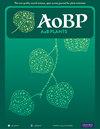Development of a Root-Zone Temperature Control System Using Air Source Heat Pump and Its Impact on the Growth and Yield of Paprika
IF 2.4
3区 生物学
Q2 ECOLOGY
引用次数: 0
Abstract
By developing and implementing a local temperature control system, such as a root zone, with a high energy efficiency heat source, we can ensure both yield and energy efficiency against extreme temperatures. This system, designed with practicality in mind, has a remarkably positive impact on paprika plants' growth and yield in greenhouse cultivation. In the summer season, paprika plants were grown with no cooling (NC), nutrient solution cooling (NSC), and the combination of NSC and substrate surround cooling (NSC+SSC). In the case of SSC, cooled water circulated through the pipe surrounding the substrate to lower the substrate temperature. The cooling system maintains the nutrient solution temperature at 18oC and the circulating water temperature at the system in the winter season; the paprika plants were grown with no heating (NH), nutrient solution heating (NSH), and the combination of NSH and substrate surround heating (NSH+SSH). The heating system maintains the nutrient solution temperature at 25oC and the circulating water temperature at 30oC. In the summer, the root fresh and dry weights, stem fresh and dry weights, stem length, and node number were increased in the NSC+SSC. In the winter season, the stem fresh and dry weights, leaf area, and leaf fresh and dry weights were increased in the NSH+SSH. In both seasons, root-zone temperature control increased the fruit quality and yield. The result indicates that this easy-to-install root-zone temperature control system can be applied to the commercial greenhouse to secure paprika growth and yield in year-round cultivation.利用空气源热泵开发根区温度控制系统及其对辣椒生长和产量的影响
通过开发和实施具有高能效热源的局部温度控制系统(例如根区),我们可以在极端温度下确保产量和能效。这一系统的设计考虑到了实用性,对温室栽培中红辣椒植株的生长和产量产生了显著的积极影响。在夏季,采用不降温(NC)、营养液降温(NSC)以及营养液降温与基质环绕降温相结合(NSC+SSC)的方式栽培红辣椒植株。在 SSC 的情况下,冷却水通过基质周围的管道循环,以降低基质温度。在冬季,冷却系统将营养液温度保持在 18 摄氏度,循环水温度保持在系统温度;在不加热(NH)、营养液加热(NSH)以及 NSH 和基质环绕加热相结合(NSH+SSH)的情况下种植辣椒。加热系统将营养液温度保持在 25 摄氏度,循环水温度保持在 30 摄氏度。在夏季,NSC+SSC 的根鲜重和干重、茎鲜重和干重、茎长和节数都有所增加。在冬季,NSH+SSH 增加了茎的鲜重和干重、叶面积和叶片的鲜重和干重。在这两个季节,根区温度控制都提高了果实质量和产量。结果表明,这种易于安装的根区温度控制系统可应用于商业温室,以确保辣椒在全年栽培中的生长和产量。
本文章由计算机程序翻译,如有差异,请以英文原文为准。
求助全文
约1分钟内获得全文
求助全文
来源期刊

AoB Plants
PLANT SCIENCES-
CiteScore
4.80
自引率
0.00%
发文量
54
审稿时长
20 weeks
期刊介绍:
AoB PLANTS is an open-access, online journal that has been publishing peer-reviewed articles since 2010, with an emphasis on all aspects of environmental and evolutionary plant biology. Published by Oxford University Press, this journal is dedicated to rapid publication of research articles, reviews, commentaries and short communications. The taxonomic scope of the journal spans the full gamut of vascular and non-vascular plants, as well as other taxa that impact these organisms. AoB PLANTS provides a fast-track pathway for publishing high-quality research in an open-access environment, where papers are available online to anyone, anywhere free of charge.
 求助内容:
求助内容: 应助结果提醒方式:
应助结果提醒方式:


